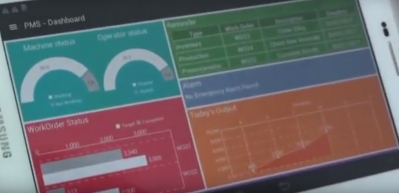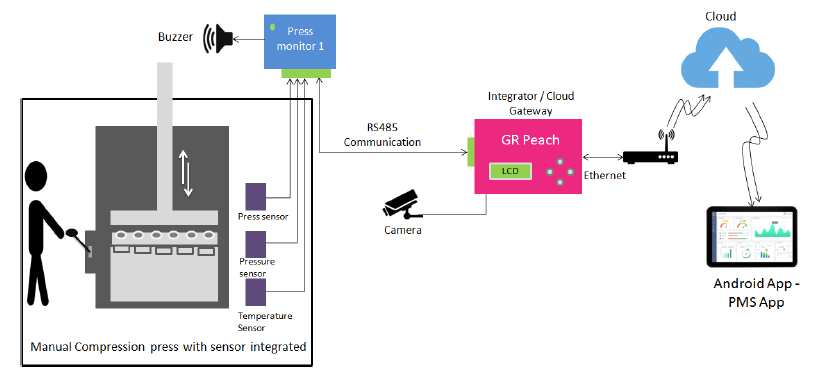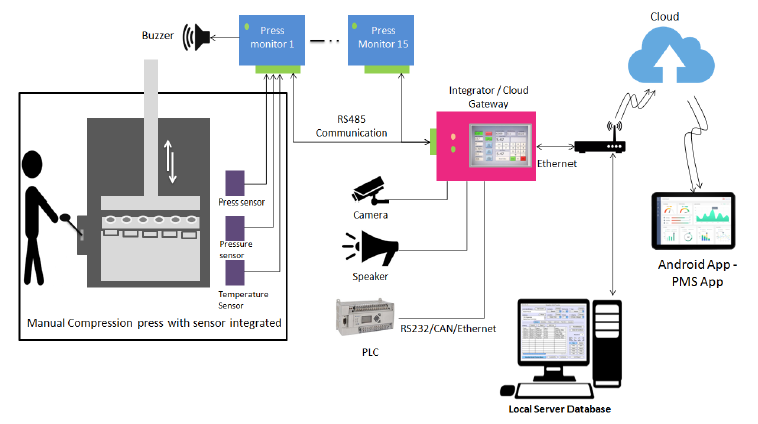Title:Production Management System with RZA1H
Displayed Name:Dhananjayan Subramanian

| Concept / Overview |
|---|
| The objective of our project “Production Management System” (PMS) is to apply the concept of “Internet of Things” (IoT) on industrial automation. The project aims to bring cloud based monitoring and management of production processes including large scale machines and even traditional manual operated machines with minor upgrades. |
Project Overview
The objective of our project “Production Management System” (PMS) is to apply the concept of “Internet of Things” (IoT) on industrial automation. The project aims to bring cloud based monitoring and management of production processes including large scale machines and even traditional manual operated machines with minor upgrades.
Here in the PMS project, the manual compression presses that are used in rubber industries are considered. The rubber valve is the finished product coming out of the production floor and they are typically used in the automobiles. To produce a quality rubber valves, there are multiple factors to be carefully governed during production process such as set temperature, pressure, press duration, etc. If any one condition is overruled, the valve will not be finished perfectly. For example, if the operator leaves the rubber sheet for more or less than the standard duration, then the shape of the valve will change or hole/cuts may occur.
Initially the rubber sheets are prepared using the raw materials such as Rubber, color mixtures, resins etc. Operators place the prepared rubber sheet into the compression press and do press actions to get the final rubber valve. Here the rubber sheets have to be left inside the machine for a standard duration to get a complete finished rubber valve. The finished rubber valve is sent to quality control (QC) to check for cuts and other damages. Here the valves are thoroughly checked and the damaged valves are rejected. After the QC process, the valves are delivered to the customer.
Now with the PMS project the above processes are completely monitored with few automations and they are listed below
1. The manual compression press is semi automated with addition of sensors and switches such that the operator will be alerted audio visually to replace the rubber sheets. This will reduce the occurrence of damages in the valves due to operator error.
2. Each operator performance is monitored such as press patterns, number of outputs per day, quality outputs vs. total production ratio, etc
3. The customer work orders are tracked with respect to the day to day production
4. Classification of the errors (operator fault or machine fault) and short listing the source of the errors
Functional Description
The block diagram of the proposed Production Management System is depicted in the following figure.

The PMS includes the following modules,
1. Press monitor with multiple sensor
2. GR peach (RZ/A1H) based integrator and cloud gateway
3. Cloud server
4. PMS App, an android application
Press monitor
Press monitor is a data acquisition device that acquires data related to the machine operations. There are three sensors inbuilt in the system to sense the parameters such as temperature, pressure and press actions. The press sensor will sense the press pattern of the operator, while the other two sensors will read temperature and pressure of the setup during the press cycle.
The Press monitor includes a LED and buzzer to indicate the Audio/visual notifications of the press cycle completion. RS485 communication supports interfacing with the integrator. Each machine will be equipped with the press monitor, sensors and connected to the integrator via RS485 communication.
A low end RL78 based MCU can be used to design the press monitor. Software is designed such that, when the operator performs the press operation, the press sensor senses the same and starts the timer. Once the predefined time is reached, the LED and Buzzer are activated to indicate audio and visual notifications. After that the press monitor waits for handle to be released and upon proper handle release, the release time is logged. For each and every cycle the logged parameters such as press duration, temperature, pressure etc are sent to the integrator through RS485 communication.
Integrator & cloud gateway
Integrator integrates data from multiple press monitors and uploads the same to the cloud server. GR peach board from Renesas is used as integrator. It includes high performance ARM Cortex–A9 core operating at 400MHz speed. Its expansion headers support multiple GPIOs, serial interface, CAN, analog inputs, camera, LCD interface etc which enables itself to be well suited for Human machine interface and it can also be used as a Press monitor for less number machines in production floors. The Ethernet connectivity supports connection to the cloud server through an external router.
16 X 2 character LCD is supported in the integrator with keypad for feeding the inputs at the start of the day such as employee ID, Machine ID, batch ID, shift etc. This also enables setting the temperature, pressure and time duration of the process. Once the data’s are fed into the device the necessary details are loaded in the cloud through Ethernet interface and the process parameters are sent to the press monitor for process automations.
The integrator is connected to cloud server through a Router with Ethernet interface. The camera interface available in the GR peach board is used to capture the live production process in the production floor. The production floor can be viewed with the live video streaming in the Android app.
Cloud server
All the production data’s that are acquired from the press monitor and user data fed in the integrator are collected and logged in the cloud server. All the computing tasks and data analytics with intelligent algorithms are performed in the cloud. The results of the analytics are logged in the cloud database in such a manner that it can be view in the Android application graphically.
For example, the customer work order completion status is generated by small computation, using the number of press the operator has made which can be sensed from the press sensor. For each press cycle, the number of materials that comes out of machine is a known value. From this we tentatively find the material produced per day by multiplying the number of press and materials output per press.
Few more analytics can be performed with the data’s such as raw material available from the inventory department (collected from integrator by manual feeding using keypad and LCD) to remind the inventory department regarding the purchase of the raw materials before the raise of production downtime due to raw material shortage.
PMS App – An Android application
PMS App facilitates viewing the results and reports that are computed in the cloud from anywhere in the world. It includes multiple widgets such as Bar charts, Pie charts, Line graphs, tables etc. This app connects with the cloud server and fetches the data from it and presents the same graphically.
This app also supports features for viewing the operator, machine information such operator attendance/performance, machine maintenance chart / performance etc. This helps to classify the faults in terms of operator or machine error.
Future Implementation
The block diagram of the future implementation of the PMS project is depicted in the below figure.

Following are the list of features that will be added in the future implementation,
1. Extension of press monitor to 15 numbers in the same RS485 communication
2. Replacing the character LCD and keypad to graphical LCD with touch screen
3. PLC interface via RS232 or CAN or Ethernet for automation in the production floors such as controlling conveyor belts, lightings, etc
4. PC based local server database with windows application for viewing the results and reports onsite
5. Support for speaker interface, in case of announcement in the site from remote location through smart phone or from within factory through mic setup.
Schematic
Finalist on GR-PEACH design contest in India 2016

